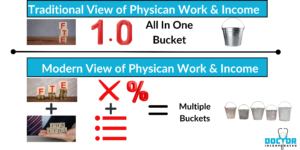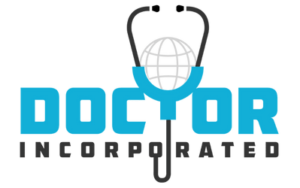[et_pb_section fb_built=”1″ theme_builder_area=”post_content” _builder_version=”4.20.0″ _module_preset=”default”][et_pb_row _builder_version=”4.20.0″ _module_preset=”default” theme_builder_area=”post_content”][et_pb_column _builder_version=”4.20.0″ _module_preset=”default” type=”4_4″ theme_builder_area=”post_content”][et_pb_text _builder_version=”4.20.0″ _module_preset=”default” theme_builder_area=”post_content”]

It’s Tax Time!
This time of the year, you are receiving various tax documents from the sources of income in your life. Like most doctors, you will receive income from various sources likely in some blend of employment (W-2) and non-employment (1099). Even with the majority of doctors choosing employment (W-2), nearly 40% of doctors have side jobs, thus 1099 income is common for many of you.
If you didn’t think about it ahead of time, your accountant who is filing your taxes is going to ask you some questions about that 1099 income-like:
What tax classification do you want to use for that 1099 income, because you have to pay taxes on it? Have you thought about this?
Rather than being reactive, and discussing this with your tax professional retro-prospectively while doing your taxes, an even better approach is to be proactive and ask yourself what is the most tax-advantaged way that you can receive all of your income—from W-2 to 1099.
Tax Planning With Your Income
Your tax professional/accountant can help you with this, and this is called tax planning.
As a doctor, tax planning is an important part of your financial planning. With the ever-changing tax laws, it is important for doctors to understand their tax obligations and plan accordingly. Tax planning can help you save money by taking advantage of deductions and credits available to you. It also helps you better prepare for retirement by making sure you are taking full advantage of all retirement plan options. By understanding the different types of deductions available, you can maximize your savings while minimizing your taxes.
So my advice is that you plan and consider the tax implications for the 1099 income before you take on that side job.
The W-9 Form
When you sign up for that job that provides you non-employee compensation you will be asked to complete an IRS W-9 form where you declare your tax classification for receiving the 1099 income.

The great thing is that you have been empowered to make this decision for yourself. The corporation paying you doesn’t do it for you.
The corporation that is paying has already exerted its power through the determination of your worker classification.
-
If they consider you an employee, you will be given the IRS form W-4 to complete which has your social security number attached to it. You will be taxed as an individual, no choice is involved. Your choices on the form will be about various factors that can influence your tax withholding’s as you it.
-
If they consider you an independent contractor, you will be given the IRS form W-9 to complete for non-employee compensation.
Once you have the W-9 form in your hand, you have to know and understand what is the best tax classification for this income for your unique tax situation.
Technically you have 7 options to choose from, but functionally for most doctors you are going to use one of these 5 classifications:
-
Individual/sole proprietor/ or single member LLC
-
C Corporation
-
S Corporation
-
Partnership
-
LLC
Most of you by default will sign up as an individual or sole proprietor and use your social security number.
This means your earnings will be added to the other W-2 earnings that are also associated with your social security number. For high-income earners like yourself, those extra dollars could push you into another tax bracket due to our progressive tax code as noted below. This means those extra earned dollars will be taxed at your highest bracket and worst of all could push your total income into the next bracket. Given your high income, neither of these is a great option because it means you will be paying the government more than a 1/3 of those dollars!

So from a tax perspective, each of the 5 tax classifications for receiving your 1099 income can provide you with the ability to pay fewer taxes on those dollars and thus retain more of those earnings. It’s up to you to work with a tax or business professional to help you decide which is best for you. As I’ll explain later, if it’s best for you to route it through a corporation, you will need an Employer Identification Number (EIN) for your form W-9.
When you provide an EIN, now the income will not be added to your W-2 earnings associated with your individual social security account. Instead, the corporation will be responsible for the taxes. For high-income earners like you, this is usually a good thing because through your corporation you will be able to retain more of those earnings and pay fewer taxes on them in comparison to dumping them into your individual earnings.
In my last blog post, I give an example of how $40,000 of side income is impacted by your worker classification decision as well as your tax classification choice. Spoiler alert—that $40k is worth a lot less if it is received as W-2 income.
Before I dig deeper into answering the question of how to classify your 1099 income, let’s do a little primer on 1099 income in general. You likely didn’t get this in medical school, in residency, or in practice. Let’s make no assumptions about this—you can speed read if it’s old information to you.
What is an IRS 1099 Form?
Form 1099 is a series of tax forms issued by the Internal Revenue Service (IRS) in the United States to report various types of income received by individuals and businesses other than salaries, wages, and tips.
It is a record to the IRS that an entity or person other than an employer paid you money. The payer fills out the 1099 form and sends copies to you and the IRS.
What is a 1099 Form used for?
The short answer is taxes. You use your IRS Form 1099 to figure out how much non-employee income you received during the year and what kind of income it was. You’ll report that income in different places on your tax return, depending on what kind of income it was.
Who Receives A 1099 Form?
All kinds of people can get a 1099 form for different reasons, but the sum is that it represents non-employment income.
For example, freelancers, independent contractors, and other gig workers who do work for other businesses often get a 1099-NEC from their clients. Doctors who are traditionally employed will get a W-2 form. But if you are working as an independent contractor for any business—whether it be long-term (employment lite) or short-term (side jobs) you will receive a 1099 form as a non-employee. The business paying you is obligated by the IRS to report your non-employee income.
I have reviewed in a prior blog post how corporations are guided by the IRS to classify your work as an employee or non-employee (independent contractor). There are advantages and disadvantages to both classifications and I have personally worked as both an employee and non-employee for the same corporation for 10 years. I have real-world experience with both in the exact same location and with the exact same employer. In my experience, in today’s system for physician work, choosing to be an independent contractor offers far more advantages than traditional employment. Therefore I recommend you work as a “1099 employee” within an employment lite agreement. But depending on your situation, traditional employment can still be a good option too.
Taxpayer Identification: Choosing To Use Your Social Security Number or Your Employer Identification Number
When you complete the form W-9 for the company paying you, you will be asked to provide a Taxpayer Identification Number (TIN). This will connect you to the 1099 income reported by that corporation to the IRS. Your taxpayer identification number (TIN) with either be your social security number or an employer identification number (if you are a business). This is the way the IRS tracks who received the money — and they will know if you don’t report that income on your tax return.
Individual Social Security Number
If you use your social security number for your taxpayer identification number (TIN) you will be taxed as an individual. Two other entities can be funneled through your social security number: a sole proprietor, or a single-member LLC (disregarded tax entity).
Sole proprietors and single-member LLCs are pass-through entities whose income is applied to your individual taxpayer account or social security account.
A Word On Single Member LLC’s
From a tax classification standpoint, sole proprietors and single-member LLCs are the same and the tax codes for a sole proprietor apply to both.
It can be a little confusing that an LLC can be taxed as an individual rather than as a corporation. But that is the case for this special corporation called a single-member LLC (Limited Liability Company) which has the power to be taxed as an individual rather than a business. By default, a single-member LLC is taxed as a sole proprietorship, which means the income and expenses of the LLC are reported on the owner’s personal tax return using Schedule C. However, the owner can also elect to have the LLC taxed as a corporation or an S corporation, depending on their preferences and circumstances.
If the owner chooses to continue to have the LLC taxed as a sole proprietorship, they will report the LLC’s income and expenses on their personal tax return. They will also be subject to self-employment tax on the net income of the LLC.
While a single-member LLC is a separate legal entity from its owner, it is a pass-through entity for tax purposes. This means that the LLC itself does not pay taxes on its income. Instead, the LLC’s income and losses are passed through to the owner’s personal tax return, and the owner pays taxes on the net income of the LLC.
Before moving on it’s important to mention that single-member LLCs are not the same thing as single-member professional corporations.
Single Member LLCs Are Different Than Single Member Professional Corporations
Single-member LLCs and single-member professional corporations are two separate forms of business organization. Although they sound similar and are both owned by a single individual, they have different legal structures.
Single-member professional corporations must file corporate income tax returns in addition to the owner having to file an individual tax return. Most commonly for doctors, this entity is classified as an S Corporation and thus its profits or losses are passed through to the individual owner’s tax return.
This is in contrast to single-member LLCs which are disregarded tax entities and thus have no responsibility to file corporate returns—thus all of its income (minus deductible business expenses) is attributed to the individual owner. This exactly the same for sole proprietors.
Single Member LLCs offer the benefit of limited liability protection for their owners, while single-member professional corporations have the potential to provide more tax benefits. Understanding the differences between these two entities is important for physician owners who want to make sure they choose the right structure for their business. A single-member LLC may not provide the same level of protection from personal liability as a professional corporation.
Given this information, most doctors in this space will choose to be sole proprietors rather than single-member LLCs.
For most individual doctors receiving any form of non-employment income, the big question is which is better?: a sole proprietor or a single-member professional corporation is best for them. I’ll tackle that in another blog post.
It is noteworthy while on this subject that single-member professional corporations will need an EIN, whereas a sole proprietor’s and single-member LLC will not depend on its tax entity declaration.
So let’s talk about Employer Identification Numbers (EIN)
Employer Identification Number
If you use your employer identification number for your taxpayer identification number (TIN) on form W-9 you are signaling to the IRS that you want to be taxed as a business entity.
Doctors, like any other business owners, can apply for an Employer Identification Number (EIN) to legally operate their businesses. This is especially beneficial for doctors who operate as a Professional Corporation (PC), Limited Liability Company (LLC), Partnership, S-Corporation, or Sole Proprietorship. An EIN allows doctors to open bank accounts in the name of their business and to pay taxes on behalf of their business. It also allows them to access certain benefits that are available only to businesses with an EIN. Obtaining an EIN is a simple process and it is essential for any doctor wanting to run a successful micro-business.
You will need this number for form W-9 if your plan is to route your non-employee compensation through your business.
A Word On Sole Proprietors
Sole Proprietors are unique in that the tax process is simpler because you do not have to obtain an employer identification number (EIN) from the IRS. You can obtain an EIN if you choose to, but you can also use your own Social Security number (SSN) to pay taxes rather than needing an EIN. You will need to let whoever is sending out 1099 know in form W-9 whether you want it connected to your social security number or your EIN.
It is noteworthy that if you plan to hire employees, you will need an EIN from the IRS whether you are a sole proprietor or a corporation. From my experience, this could come into play if you hire a family member to do some work for the corporation. For instance, my wife is employed by my corporation as my bookkeeper, and I have hired my children to do various jobs over the years. It is not uncommon for small business owners to hire family members—mostly for convenience but also because it keeps all the dollars within the household.
17 Common Types of 1099 forms
Overall there are more than 17 types of 1099 forms that you are likely to encounter, for a complete list from the IRS go here. The most common you are likely to see is the 1099-NEC.
1099-NEC
In 2020, the IRS rolled out the 1099-NEC, which companies now use to report money paid to people who did work for them but weren’t employees. In other words, if you freelanced, were self-employed, or had a side gig, the company you worked for should send you a Form 1099-NEC in early 2023. This is required by the IRS if the compensation was $600 or more.
Diverse Work Arrangements
1099-NEC income is increasingly common for doctors who really function as both long-term and short-term independent contractors in our healthcare economy. Just like the rest of the world, one of the many legacies of the COVID pandemic has been a new diversity in work arrangements.
If you want to work full-time in a clinic or hospital five days a week, plenty of jobs still offer that schedule. If you want a % of a full-time equivalent position, you can choose that route. If you want to work more or harder to reach a performance bonus, you can do that too.
You can now choose a job that allows you to work from home full-time even, or maybe even live thousands of miles from the work location. In the past year, I have spoken to numerous physicians whose professional services lend themself to remote work that allows them to do just this, live in a preferred location, yet do their work in a less desirable location.
There is a whole mix-mash of jobs that doctors now will piece together to diversely do their work. The old idea of one doctor in one location doing one job is being replaced by one doctor in multiple locations doing multiple jobs. I discussed this in more detail in my last blog post, but here is a picture of what that looks like.

This is the new normal, a unique combination of work and income that is shaped around a doctor’s preference. Those diverse income channels will create a combination of W-2 and 1099 income. Every doctor will have to choose the tax classification they prefer for those dollars, but it will likely be either as a sole proprietor or as a single-member professional business (PC/PLLC). I’ll spend an entire upcoming blog post discussing this.
This rise in 1099 income for doctors foreshadows the growing space of doctors working as “1099 employees”. This progressive descriptor represents the needed systemic physician labor change for both doctors and employers. Tune in next week as I talk more about this game-changer.

[/et_pb_text][/et_pb_column][/et_pb_row][/et_pb_section]


